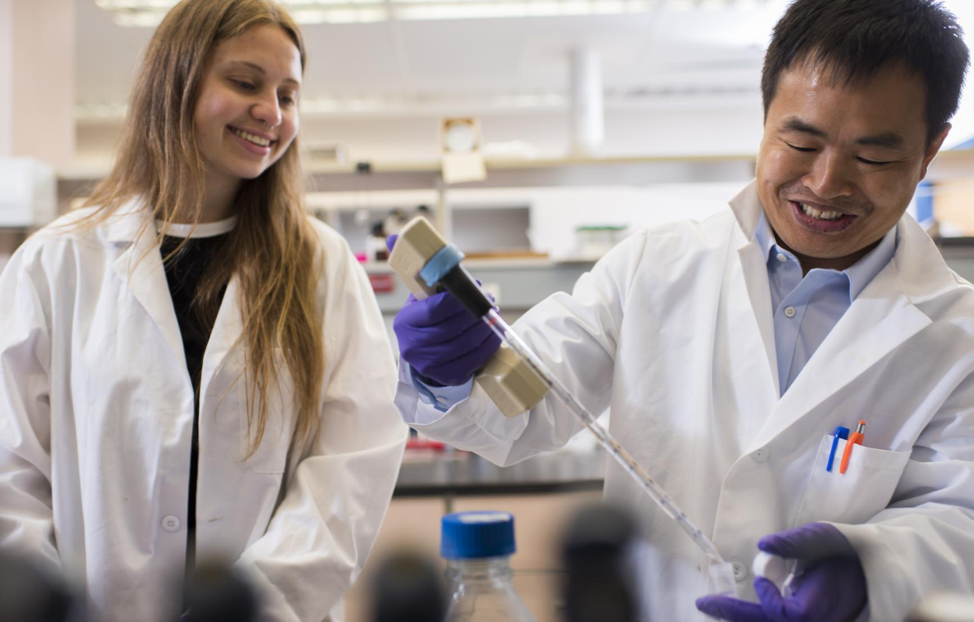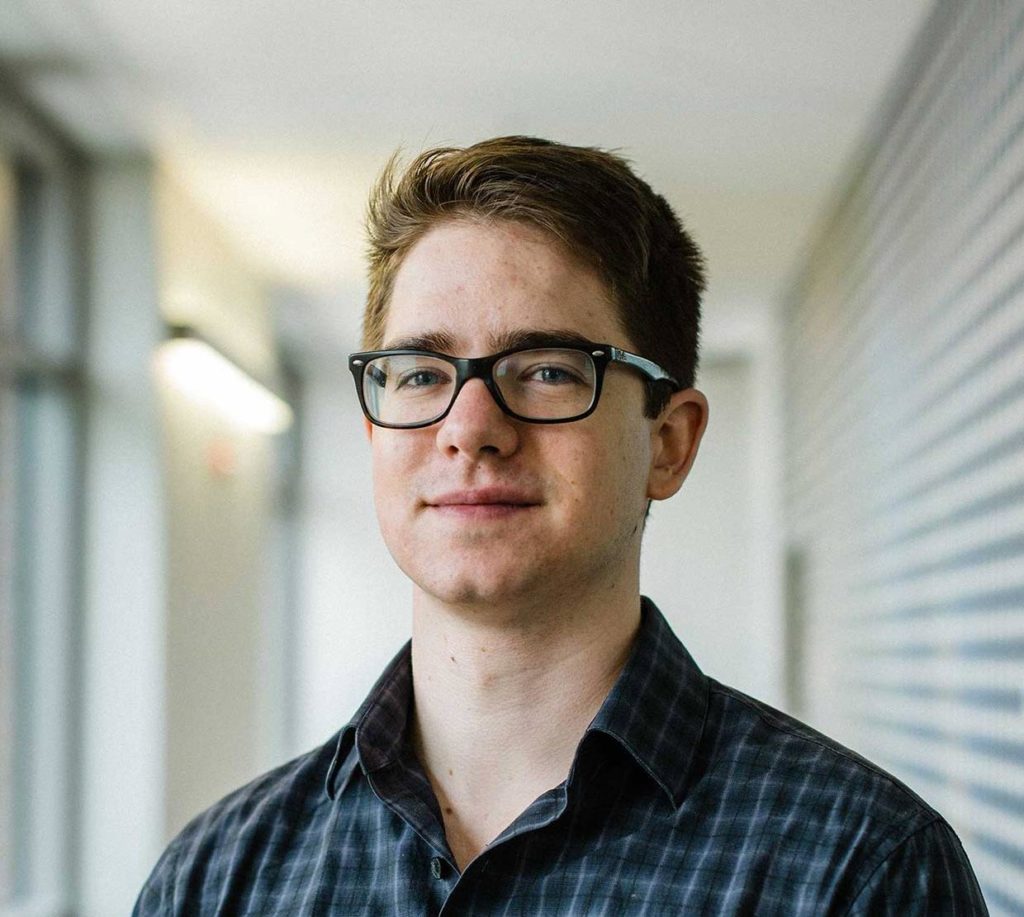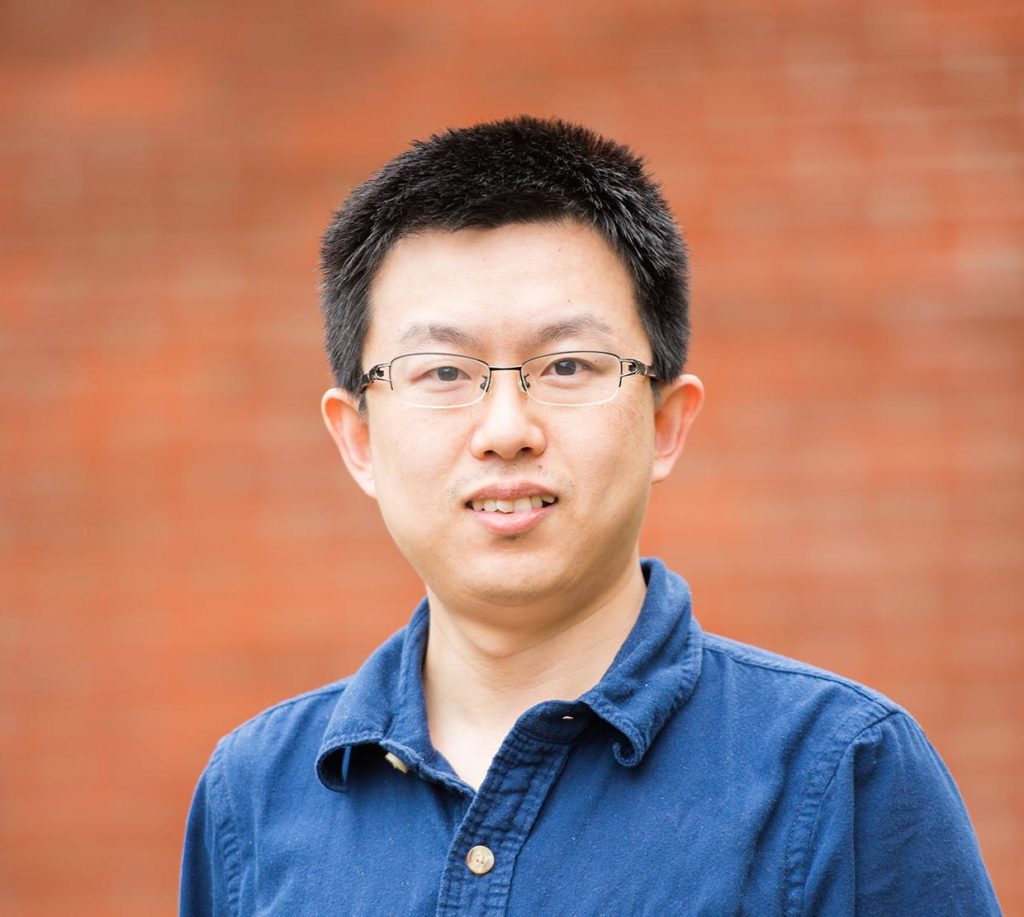Dr. Walsh received College of Science Faculty Scholar award for recognition of his exceptional contributions to his discipline and Oregon State University. This is a three-year titled endowed position. See more details at https://internal.science.oregonstate.edu/faculty-and-staff-awards/college-science-whiteley-faculty-scholar-teaching-excellence-award-and-osu
Category Archives: Awards
Physics students won prestigious awards
Nima Laal received 2022-2023 Larry W. Martin & Joyce B. O’Neill Endowed Fellow in the College of Science.
Isak McGieson received DOE Graduate Student Research (SCGSR) program award.
Congratulations to both!
Physics faculty honored at College Awards Ceremony
It was a banner day for Physics at the College of Science Awards Ceremony on Tuesday, February 22, 2022 (lots of twos, too).
Liz Gire won the Frederick H. Horne Award for Sustained Excellence in Teaching Science. A master innovator in teaching, Liz earns accolades for her skill in communicating difficult topics and her ability to pitch physics at the right level for her students. A student wrote, “Her level of dedication to the genuine support and inclusion of the students in her courses is something I’ve never seen in an educator before. She backs that up with her skill and experience in education and communication that makes difficult content still accessible and enjoyable to learn.” Read more at the College of Science Impact Magazine.
Matt Graham was presented with the Industry Partnership Award for his work on harnessing waste heat. Matt has worked with several companies over the past several years on projects that have led to Ph.D. theses for his students.
Davide Lazzati earned this year’s Milton Harris Award for his outstanding work in the field of high-energy astrophysics. His pioneering considerations of electromagnetic signatures of neutron star mergers hav produced some of the most detailed predictions of compact binary mergers, perhaps one of the most exciting topic in astrophysics in the past decade. Read more at Impact Magazine.
Heidi Schellman is this year’s Gilfillan Awardee. The F.A. Gilfillan Award for Distinguished Scholarship honors faculty members in the College of Science whose scholarship and scientific accomplishments have extended over a substantial period of time, especially faculty whose research careers have had a significant impact on his or her field. Heidi’s work in neutrino physics is just part of her work leading to 700 peer-reviewed publications and an h-index of 113. She has contributed to several well-known scientific collaborations and currently serves in a leadership position for the Deep Underground Neutrino Experiment (DUNE). Read more at Impact Magazine.
Isabel Rodriguez is the 2021 Harriet “Hattie” Redmond Awardee!

Congratulations to Isabel Rodriguez, M.S. for being the 2021 recipient of the Harriet “Hattie” Redmond Award! This award celebrates a member of the OSU community who works as an agent of change in service of racial justice and gender equity. This ” Breaking Barriers” award is sponsored by the President’s Commission on the Status of Women (PCOSW), the Office of Institutional Diversity (OID), the Office of the Provost and OSU Athletics.
https://leadership.oregonstate.edu/pcosw/events/breakingbarriers
Isabel is a brilliant example of a scientist who works tirelessly and effectively for change in service of racial justice and gender equality. The STEM culture at Oregon State University is changing profoundly because of her influence. As a Black woman in astrophysics, she has expertly navigated the terrain in this white-male-dominated field to emerge as a powerful example to other marginalized people of how to be successful on their own terms and teaching her mentors to change the ways they interact with their students.
Isabel has been a powerful agent of change in our Department and College. She has challenged her research group, her peers, her mentors and the administration to look at our workplace differently and through the eyes of those marginalized. As an elected member of the graduate student committee, she helped lead discussions among the faculty and students in a series of Town Hall meetings that ultimately resulted in significant changes to the physics graduate program to make it more fair, flexible, and inclusive. She has also been an important member of the departmental DICE committee and a founding member of CoSMAC, the College of Science Multidisciplinary Antiracism Coalition, which advocates for the adoption of antiracist policies, practices, and actions in the College. She was also Vice President of the Black Graduate Student Association, where she organized regular on-campus events to foster a sense of community and belonging for Black undergraduate and graduate students. For her positive, measured and always relentless advice and guidance, Isabel is a worthy member of a spectacular group of leaders that have been recognized with the Harriet “Hattie” Redmond Award.
Thank you for your service Isabel, and for raising our collective consciousness.
2020 SURE Awards
Physics students and faculty are well-represented in the College of Science 2020 Summer Undergraduate Research Experience (SURE) Awards. These awards provide 11-week employment in the summer for students, though this year, because of closures during the covid-19 pandemic, the research may have to be stretched out over the academic year.
This year’s physics student awardees are:
Hunter Nelson advised by Tuan Pham (Mathematics)
Rohal Kakepoto advised by Janet Tate
Alan Schultz advised by Hoe Woon Kim (Mathematics)
Alexander van Balderen advised by Liz Gire
Jessica Waymire advised by Matt Graham
Ryan Wong advised by Bo Sun
Students from other departments working with Physics faculty are:
Emily Gemmill, (Biochemistry & Biophysics), advised by Weihong Qiu
Ruben Lopez (BioHealth Sciences) advised by Bo Sun
Congratulations all!

Mirek Brandt, Katelyn Chase & Patrick Flynn (Physics 2018) awarded NSF Graduate Research Fellowships
Three OSU Physics alums are among 2,046 graduate students nationwide to receive the NSF Graduate Research Fellowships Program award that pays stipend and partial tuition for 3 years. Congratulations to all three! See the Impact article from the College of Science for some more details about other College of Science GRFP recipients.

Mirek Brandt (BS in Physics & Mathematics 2018) worked in the Graham group while at Oregon State. His thesis was on The Impact of Crystal Morphology on the Opto-Electronic Properties of Amorphous and Organic Crystalline Materials. He won a Goldwater Scholarship as an undergraduate and then moved on to the University of California at Santa Barbara where he is doing his doctorate in Astrophysics.

Katelyn Chase (BS in Physics 2018) worked in Bo Sun’s biophysics laboratory during her time at OSU and wrote her thesis on Synchronized Cellular Mechanosensing due to External Periodic Driving. She is now a Ph. D. candidate at the Lewis-Sigler Institute for Integrative Genomics at Princeton University, conducting research in the Gitai bacterial biology laboratory, studying cytoskeletal proteins. She is interested in proteins involved in bacterial cell shape formation and maintenance. Her photo shows her in Iceland in January.

Patrick Flynn (BS in Physics and Mathematics, 2018) did his senior thesis project on Localized structures in a diffusive run and tumble model for M. xanthus, as part of the Complex Systems REU at the University of Minnesota with Arnd Scheel (Bo Sun was the local advisor). Patrick also contributed to the linear solver code for the Monte-Carlo simulations performed in David Roundy’s research group in Physics. Patrick is now a Ph. D. candidate in the Department of Applied Mathematics at Brown University. He is studying the Euler- and Vlasov-Poisson models appearing in plasma and astrophysics. His NSF GRFP proposal was about answering questions such as the existence and stability of solitary waves, or the existence of solutions containing many interacting solitary waves, for the Euler- and Vlasov-Posson equations. Patrick says he is “very enthusiastic about being able to address questions that have been partially addressed by the physics community to discover new mathematics, and in turn inform scientific discovery. Of course, my time at Oregon State was very formative in this regard, and I still heavily rely on what I learned in the mathematics and physics programs there. After all, I first learned what a dispersion relation was from David Roundy!” The accompanying picture shows Patrick on the Brown Campus.
See the Impact article from the College of Science for some more details about College of Science GRFP recipients.
Prof. Bo Sun received the 2019 Richard T. Jones New Investigator Award

In December 2019, Associate Prof. Bo Sun received the Richard T. Jones New Investigator Award from the Medical Research Foundation of Oregon for his work on the biophysics of collective behavior in cells.
For more details on the award see the MRF awards site and the longer College of Science IMPACT article about Bo’s work.
And check out his research group at https://sites.google.com/site/biophysicsbosun/ to read about the successes of the large number of graduate and undergraduate students working in his lab.
Congratulations Bo!
Prof. Bo Sun receives an NSF CAREER award for cellular sensing research
Prof. Bo Sun has received an NSF CAREER award for his biophysics research. Please look at the longer IMPACT article for details. (And he’s also the 2019 Richard T. Jones New Investigator Award for the Medical Research Foundation of Oregon, more details on that after the ceremony in Portland later this term.)

Graduate Student Robert “Jake” Jacobs wins a NASA FINESST Award

Robert “Jake” Jacobs has been awarded a NASA Future Investigators in NASA Earth and Space Science and Technology (FINESST) award for 2019 in the competitive Earth Science Division. With this award, he is developing a method to analyze latitudinal circulation utilizing satellite measurements of ocean surface vector winds measured by the QuickSCAT and ASCAT scatterometers. Our objectives are to improve understanding of climatological atmospheric circulation patterns and how surface winds in the tropical Pacific influence El Niño-Southern Oscillation (ENSO) events. Latitudinal circulation plays an important role in weather and climate variability as it shapes where precipitation falls and how heat moves from the equator to polar regions. Improved accuracy of the boundaries between large-scale atmospheric cells can advance our understanding of climate and weather models.
Robert “Jake” Jacobs has been awarded a NASA Future Investigators in NASA Earth and Space Science and Technology (FINESST) award for 2019 in the competitive Earth Science Division. With this award, he is developing a method to analyze latitudinal circulation utilizing satellite measurements of ocean surface vector winds measured by the QuickSCAT and ASCAT scatterometers. Our objectives are to improve understanding of climatological atmospheric circulation patterns and how surface winds in the tropical Pacific influence El Niño-Southern Oscillation (ENSO) events. Latitudinal circulation plays an important role in weather and climate variability as it shapes where precipitation falls and how heat moves from the equator to polar regions. Improved accuracy of the boundaries between large-scale atmospheric cells can advance our understanding of climate and weather models.
This type of work while exciting is not new, as astronautical projects have been a driving force in Jake’s life. His passion for space has taken him from an undergraduate degree in Aerospace Engineering, from Purdue University, to satellite remote sensing at Oregon State University (OSU) where he is completing a PhD in Physics. Before arriving at OSU, Jake obtained a master’s degree in physics from Eastern Michigan University (EMU). While there, he worked with funds from the NASA Space Grant to develop an ion source that would be used in sputtering experiments to model the solar wind.
Connecting with his advisor, Dr. Larry O’Neill at OSU, has created an excellent partnership, as they bring different strengths to the table. Dr. O’Neill’s wealth of experience has helped Jake to greatly advance his knowledge of atmospheric and oceanic sciences. While Jake’s physics and math background have assisted with advancing spatial derivative analysis techniques. This newest project has combined Jake’s passion for physics and math with a novel astronautical venture. He greatly looks forward to continuing this project with the support of the FINESST Fellowship.
In his limited free time, Jake enjoys reading, hiking, swimming and playing disc golf with his two small children, wife and two dogs. An extra joy in his life is watching his children grow to love the universe and all its boundless opportunities. The family also enjoys star gazing, which can be difficult in Oregon, so they use a home star theater system to learn about space, stars and the world above.
Graduate Student Tyler Parsotan wins a NASA FINESST Award

Tyler Parsotan has been awarded a NASA Future Investigators in NASA Earth and Space Science and Technology (FINESST) award for 2019 in the extremely competitive Astrophysics category. His proposal, titled “Demystifying the Interplay between Explosion Dynamics and Electromagnetic Radiation in Gamma Ray Bursts”, was one of the 11% of selected proposals in this category.
Originally from NY, Tyler is a first generation student. His family is from the Caribbean island nation of Trinidad and Tobago. He acquired a BS in Space Physics from Embry-Riddle Aeronautical University and is now working on a PhD in Physics at Oregon State University.
Tyler is currently a fourth year graduate student working with Dr. Davide Lazzati on understanding the most powerful explosions in the Universe known as Gamma Ray Bursts. These events are so energetic that in the first few seconds of the explosion, they release more energy than our sun will emit in its entire lifetime. Understanding these events allows us to get a better handle on how matter behaves in extreme conditions and may eventually lead to using these Gamma Ray Bursts as tools that can uncover new cosmological truths.
Besides working on his research project, Tyler is the president and co-founder fo the OSU astronomy Club. The club is focused on fostering interest in astronomy at OSU and the community of Corvallis in general. Tyler, with the help of many other undergraduate and graduate students, has hosted the Astronomy Open House events where members fo the public are invited to Weniger Hall to learn about astronomy though interactive demos and rooftop observations. More information regarding OSU Astronomy can be found at: https://physics.oregonstate.edu/astronomy-club
